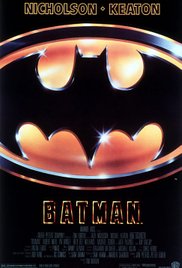 When Warner Brothers announced that they were going to make a “Batman” movie modeled after the Dark Knight series of the comic, the fan boys roared with approval. Then they announced that Michael Keaton would be Bruce Wayne, and Tim Burton, who only had two movie credits to his name at the time (“Pee Wee’s Big Adventure,” “Beetlejuice”) would direct. The Comic Book Guys were appalled. Advance buzz was troublesome, with other studios wondering if Warners was about to make “Superman 5.”
When Warner Brothers announced that they were going to make a “Batman” movie modeled after the Dark Knight series of the comic, the fan boys roared with approval. Then they announced that Michael Keaton would be Bruce Wayne, and Tim Burton, who only had two movie credits to his name at the time (“Pee Wee’s Big Adventure,” “Beetlejuice”) would direct. The Comic Book Guys were appalled. Advance buzz was troublesome, with other studios wondering if Warners was about to make “Superman 5.”
Warner Brothers, meanwhile, breathed comfortably. In fact, they didn’t even bother to screen the movie. They knew they were sitting on a gold mine.
“Batman” completely rewrote the rules for how summer blockbusters were made, how they were promoted, and how they were expected to perform. Its $42 million opening weekend was staggering for the time, easily making back its $30 million budget. Keaton turned out to be an excellent choice for Bruce Wayne, making him guarded but vulnerable. Burton, who was only 30 at the time, showed remarkable vision as well as restraint, treating the source material with the respect it deserved. And then there’s Jack Nicholson, whose portrayal of the Joker is the most nuanced performance, from a villain or hero, that you’ll ever find in a comic book adaptation.
Set in the ageless, timeless Gotham City, the police are hearing stories about a vigilante crime fighter who’s cleaning up the town on his own. Investigative reporter Knox (Robert Wuhl) is on the trail, but gets sidetracked by photographer Vicki Vale (Kim Basinger), who’s come to get some pictures of this mysterious “Bat Man.” Vale soon meets cute with Bruce Wayne (Keaton) at a benefit, completely unaware of his alter ego. But Wayne has bigger problems. Jack Napier (Nicholson), a loose cannon henchman of local crime boss Grissom (Jack Palance), has plans to take over the business, and after a horrific accident at a chemical plant leaves him disfigured, Napier, who’s christened himself the Joker, steps up the offensive, on both the city and Batman.
To call “Batman” an action movie is misleading. In fact, it’s more like a very colorful crime thriller, with a twisted character study at its core. The scene at the museum, set to Prince’s excellent “Partyman,” (they were actually listening to “1999” when they shot the scene) may be raucous, but it’s really a big, loud setup to a quiet conversation between the Joker and Vale. In fact, the quietest lines are the most memorable (“Where does he get those wonderful toys?” and “Never rub another man’s rhubarb,” to name but a couple). You get the sense that the Joker is trying his damndest to maintain his sanity, but is slowly unwinding before your eyes. That Nicholson could make this homicidal maniac so sympathetic is a testament to his performance.
If there’s anything that’s off in “Batman,” it’s Basinger’s Vicki Vale character. She seems to serve little purpose outside of the damsel in distress (and she’s in constant distress). Wuhl may have been upset that Knox didn’t come back for “Batman Returns,” but there was really no place or need for him. Billy Dee Williams played Harvey Dent with the goal of becoming Two Face later, so one wonders how upset he was when the studio bought out his contract and offered the role to Tommy Lee Jones for “Batman Forever.”
The most ironic thing about the tremendous success of “Batman” was that people seemed to instantly forget what made that movie work so well. “Batman Returns” was delightfully weird, but despite their efforts to develop the villains, it doesn’t nail the landing the way “Batman” did. The two Joel Schumacher sequels (1995’s “Batman Forever,” 1997’s “Batman & Robin”) didn’t even try, choosing style over substance. In retrospect, the most worthy successors to “Batman” are Sam Raimi’s “Spider-Man” movies. Which is why everyone waits impatiently to see what Christopher Nolan has up his sleeve for “Batman Begins,” and whether it will be the follow-up “Batman” so richly deserved.
 (4 / 5)
(4 / 5)



